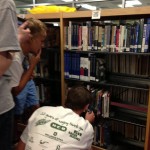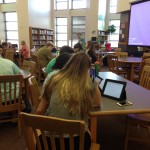Setting the Stage
A few weeks ago, our junior English teachers approached me with the idea of deepening their students’ knowledge about how to use databases and other services like Google search tools and Google Scholar. But rather than asking me to give their classes the typical brief overview, they allotted a whole class period, and suggested perhaps a scavenger hunt model would engage students(agreed!). We talked about what skills they wanted students to get better at, what tripped them up with researching on databases, and how to structure combining several classes at once to do this together. All this was in preparation for some research they were doing in book study groups a few days later.
Additionally, this assignment really meshed with our district library essential questions: “What does it mean to be curious?” and “How can I explore?”
Creating the tool
I decided to construct some pathfinders using a basic Wikispaces page with a series to steps designed to guide them through some focused searches. Rather than to create a scavenger hunt in isolation from their curriculum, I decided to build it around the themes in their summer reading books. So the main landing page of the wiki had general instructions, but each team had a different page with different questions on it. My hope was to make the results more pertinent for them and make it a “pre-search” activity for their real searching later in the week.
That evening after a Back to School night event, I reflected that the wiki “looked” sort of dullish just because of the formatting. I wondered if adding a gaming element to the page would engage students better, so I decided to create several headings or “levels” for the questions. So as they progressed through the searches, they would periodically see something like “Level Two: Congratulations, you’ve reached the second level!” Or “You win the gold coin for completing this section!” I wasn’t sure with no graphics added if that would provide any extra incentive, but since I didn’t have time to set those up, I thought it would be a good experiment.
 Wanting to make it more scavenger hunt like and to have some movement to engage their brains , we added in a couple of moments that required students to work as a team and move around the library. To begin with, students sat with their previously existing book study groups(from their summer reading choice titles). We then gave each group a slip of paper with a book title on it(related to the themes of their own book). I gave an overview about where to find things on our library webpage and a global perspective on databases and Google, and then we set off. First off each team had to use the online catalog to look up their book title and then they had to locate it on the shelf. Once they located it, we had placed a QR code on the shelf near the title with a link to the Wikispaces page.
Wanting to make it more scavenger hunt like and to have some movement to engage their brains , we added in a couple of moments that required students to work as a team and move around the library. To begin with, students sat with their previously existing book study groups(from their summer reading choice titles). We then gave each group a slip of paper with a book title on it(related to the themes of their own book). I gave an overview about where to find things on our library webpage and a global perspective on databases and Google, and then we set off. First off each team had to use the online catalog to look up their book title and then they had to locate it on the shelf. Once they located it, we had placed a QR code on the shelf near the title with a link to the Wikispaces page.
Many students(despite having 1:1 iPads) did not have QR code readers so I was glad that I had included a link to the site below the QR code on the shelf. (Note to self–students aren’t using QR codes).
Getting students moving
The librarians acted as facilitators and answered questions if students needed help locating something. What we learned? Some students didn’t know how to find call numbers in the catalog or weren’t too sure how the books were arranged or a system for finding them(not that surprising, but an area for growth). We also realized our signage could be improved to help them find things much more easily. Teachers also realized that students may not have the skills they were assuming they had.
 In the middle of the online scavenger hunt, we interspersed a “brain break” – again, to get students moving and give them a break from the searching. Borrowing from Ewan Mcintosh’s work at NoTosh, I decided to have students brainstorm UnGoogle-able questions” on our new Huddle whiteboards. It also allowed them to work as a team to consider what Google could not help them with, and many of the groups were empowered by brainstorming questions.
In the middle of the online scavenger hunt, we interspersed a “brain break” – again, to get students moving and give them a break from the searching. Borrowing from Ewan Mcintosh’s work at NoTosh, I decided to have students brainstorm UnGoogle-able questions” on our new Huddle whiteboards. It also allowed them to work as a team to consider what Google could not help them with, and many of the groups were empowered by brainstorming questions.
Overall, it felt like this method provided a much more successful way for students to engage with the databases and Google tools much more deeply and it was definitely more effective with three combined classes to do it this way.
Most of the teams gelled and helped one another with the questions and answers, using both their phones and iPads to follow along. A few groups of course let one or two people do the work, so they didn’t really experience the database at all, which was a downside. This was harder to manage in the larger groups. But overall, most of the students were fully engaged, and we heard very positive responses, such as students commenting that this would really help them in other classes, or that it was a more motivating way to learn. The gamification element was definitely noticed-I saw students giving each other “high-fives” for finishing a level and sharing with one another what “level” their team was on, so that was a good reminder to me that even simple ways of gamifying a learning activity pay off.
 We ended the pathfinder with a Google form for student feedback. The feedback made it clear that students made more distinctions about which tool to use when searching, so it appears that large numbers of them met our learning goal. I also plan to conference with the teachers next week after students do in class research to see if it made a noticeable difference in their comfort level with the tools when they actually began their research.
We ended the pathfinder with a Google form for student feedback. The feedback made it clear that students made more distinctions about which tool to use when searching, so it appears that large numbers of them met our learning goal. I also plan to conference with the teachers next week after students do in class research to see if it made a noticeable difference in their comfort level with the tools when they actually began their research.
Feedback loop
I was thrilled to have the opportunity to really help them dig deeper into using all the tools that the databases and Google have available for more effective searching. And it gave me and our other librarian a great opportunity at the beginning of the year to work alongside the students and connect with them since our school is quite large.
This collaboration was more possible also because we have PLC time (Professional Learning Communities) built into our day so that teachers work with their grade level teams and can meet with us as a team. This makes it much more conducive to this sort of joint planning that is hard to do at the high school level.